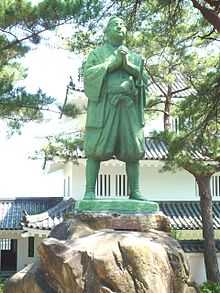Amakusa Shirō

Amakusa Shirō (天草 四郎, 1621? – April 12, 1638) also known as Amakusa Shirō Tokisada (天草四郎時貞) was the teenage leader of the Shimabara Rebellion.
Biography
The son of former Konishi clan retainer Masuda Jinbei (益田 甚兵衛) (according to some sources, Shirō may have been the illegitimate son of Toyotomi Hideyori), Shirō was born in modern-day Kami-Amakusa, Kumamoto in a Catholic family. The charismatic 15-year-old was known to his followers as "heaven's messenger." Miraculous powers were attributed to him.[1]
Shiro led the defence of Hara Castle and defeated the strongest of the Shogunate attackers in a series of coordinated defensive surges. Due to the fact that the rebel force had no logistical support, their morale was seriously weakened in the following days. Shiro displayed posters in the castle in an attempt to enhance the morale of rebel force, saying "Now, those who accompany me in being besieged in this castle, will be my friends unto the next world." A rebel soldier, Yamada Uemonsaku, betrayed Shiro and notified the Shogunate of the truth that rebel food supplies were becoming strained. The Shogunate forces performed a final assault, taking Hara Castle in the process. The Shogunate forces massacred almost 40,000 rebels, including women and children. Yamada, who previously betrayed his fellow rebels, was the only recorded survivor.
Death
Shiro was executed in the aftermath of the fall, his head being displayed on a pike in Nagasaki for an extended period of time afterward as a warning to any other potential Christian rebels. His final words were: "I shall return after 100 years and take my revenge." Even now, many Japanese Christians consider Shiro as a saint, but the Roman Catholic Church has not officially listed him as such.
In popular culture
- Shiro is featured as a character in Fate/Apocrypha.
- He is the central antagonist in the Japanese manga XBlade by Satoshi Shiki.
- He is featured as a mitama in the PlayStation Vita role-playing video game Toukiden: The Age of Demons.
- In the manga Amakusa 1637, Shiro is never executed but is instead made into the slave of the mentally unstable time traveler Naozumi "Kotaka" Yatsuka, who sees him as a stand-in for his unrequited love Natsuki (who bears an uncanny physical resemblance to Shirou). Despite Naozumi's physical and sexual abuse of him, Shirou treats him kindly and tries to reason with him instead, in hopes to make him an ally of the oppressed Christians and help him be redeemed. When Naozumi realises how Shirou is getting under his skin, however, he react with fright and strangles him to death.
- In the videogame saga Samurai Shodown, Amakusa is one of the main antagonists. Having lost his faith in the Christian God, Shiro fell in despair and made a deal with the devil with the demon Ambrosia before dying, which would led him to possess the body of a boy named Shinzo (the son of Hanzo Hattori) and return to Earth as a powerful sorcerer, starting to spread chaos across Japan in revenge for his unfair death. After being defeated by the heroes, his soul is split in two: one half is still a villain and keeps committing atrocities, the other is driven by his desire to atone for his terrible sins.
- In the videogame Live A Live he appears as a spirit and is one of the enemies of the Secret Orders chapter.
- The character Amakusa Shougo from the anime Rurouni Kenshin was based on Amakusa Shiro. He and his followers are rescued from the Hara Castle siege by the protagonist and a Dutch ambassador and exiled to Holland.
- He is a central character in the film Samurai Reincarnation, in which he is resurrected from the dead.
- He is a summonable demon known as simply Tokisada in MMORPG Shin Megami Tensei: Imagine and Nintendo 3DS role-playing video game Shin Megami Tensei IV
- The Gundam manga Crossbone Gundam: Skull Heart and its sequels feature a Mobile Suit powered by a clone of original Mobile Suit Gundam protagonist Amuro Ray's brain known as the Amakusa, referencing Amuro's Japanese heritage and his martyrdom at the end of Mobile Suit Gundam: Char's Counterattack.
- In the anime series Kindaichi Case Files, Hajime Kindaichi went to the fictional Amakusa Island where Amakusa Shiro rumoured to have hidden a treasure cave.
References
- ↑ Michael Hoffman, The Christian Century, Japan Times, Dec. 2007
Further reading
- Ivan Morris. The Nobility of Failure: Tragic Heroes in the History of Japan. London: Secker and Warburg (1975)
External links
- Amakusa Shirō Tokisada Web (Japanese)
- Amakusa Shirō (Kumamoto Rekishi Jinbutsu) (Japanese)
This article incorporates text from OpenHistory.